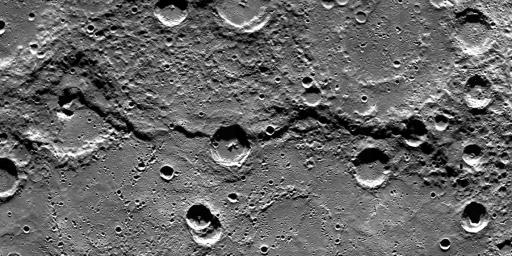
|
V for Victoria
- Click the image above for a larger view
- Full-Res JPEG (2048 x 1024) (581.9 kB)
- Full-Res TIFF (2048 x 1024) (2.1 MB)
Caption:
This image is a portion of the MDIS global mosaic basemap that was acquired during MESSENGER's first year in orbit. The scene, with north to the right, shows a geological feature termed Victoria Rupes -- a long cliff or scarp that formed when Mercury shrank slightly as its core cooled. Rupes on Mercury are named for ships of discovery, and Victoria Rupes is named for the Victoria that formed part of Ferdinand Magellan's fleet in his 1519-1522 effort to circumnavigate Earth.
This geologic feature is of particular interest to MESSENGER scientists because it is part of a larger, linear set of contractional structures that may correspond to what is termed a fold-and-thrust (FAT) belt on Earth. FAT belts are common terrestrial surface features, and form when the crust is shortened due to compressional tectonism. Identifying FAT belts on Mercury will help scientists understand in more detail how that planet's crust has deformed through time.
Date Created:
February 10, 2012
Instrument:
Wide Angle Camera (WAC) of the Mercury Dual Imaging System (MDIS)
Latitude Rang:
47° N to 59° N
Longitude Range:
321° E to 331° E
Resolution:
250 meters/pixel
Scale:
The crater just left of center is approximately 42 km (26 mi.) in diameter
Projection
: Azimuthal equidistant
Background Info:
The MESSENGER spacecraft is the first ever to orbit the planet Mercury, and the spacecraft's seven scientific instruments and radio science investigation are unraveling the history and evolution of the Solar System's innermost planet. Visit the Why Mercury? section of this website to learn more about the key science questions that the MESSENGER mission is addressing. During the one-year primary mission, MDIS acquired 88,746 images and extensive other data sets. MESSENGER is now in a year-long extended mission, during which plans call for the acquisition of more than 80,000 additional images to support MESSENGER's science goals.
These images are from MESSENGER, a NASA Discovery mission to conduct the first orbital study of the innermost planet, Mercury. For information regarding the use of images, see the MESSENGER image use policy .
Cataloging Keywords:
| Name | Value | Additional Values |
|---|---|---|
| Target | Mercury | |
| System | ||
| Target Type | Planet | |
| Mission | MESSENGER | |
| Instrument Host | MESSENGER | |
| Host Type | Orbiter | |
| Instrument | Mercury Dual Imaging System (MDIS) | |
| Detector | Wide Angle Camera (WAC) | |
| Extra Keywords | Crater, Grayscale, Map, Radio | |
| Acquisition Date | ||
| Release Date | 2012-04-23 | |
| Date in Caption | 2012-02-10 | |
| Image Credit | NASA/Johns Hopkins University Applied Physics Laboratory/Carnegie Institution of Washington | |
| Source | photojournal.jpl.nasa.gov/catalog/PIA15614 | |
| Identifier | PIA15614 | |
